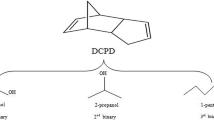Abstract
The transportation industry demands the flammability control in the safe transportation of any liquid mixtures. Here the flashpoint of a flammable solvent is controlled by adding an evaporative diluent into the mixture. The flashpoint of this binary mixture is predictable with the help of Method of Flammable Resistance. Here methanol and heptane were chosen as typical fuels to be tested while R141b and R1233zd were added to control the flashpoint. Experimental results show that the binary mixture demonstrated the predicted behavior with the help of a new modeling scheme for mixing and the activity models for non-ideal evaporation. This methodology has the potential for predicting the flashpoint of any combinations of solvents, though some kind of synergistic behavior may appear when small fraction of a diluent is involved.









Similar content being viewed by others
References
Fujii A, Hermann ER (1982) Correlation between flash points and vapor pressures of organic compounds. J Safety Res 13(4):163–175
Thiele EW (1927) Prediction of Flash Point of Blends of Lubricating Oils1. Ind Eng Chem 19(2):259–262
Catoire and Laurent (2004) a unique equation to estimate flash points of selected pure liquids application to the correction of probably erroneous flash point values. J Phys Chem Ref Data 33(4):1083–1111
Hristova M, Damgaliev D, Hristov J (2011) Practical data correlation of flashpoints of binary mixtures by a reciprocal function: the concept and numerical examples. Therm Sci 15(3):905–910
Astray G et al (2013) Esters flash point prediction using artificial neural networks. J Comput Chem 34(5):355–359
de Oliveira FM et al (2017) Predicting cetane index, flash point, and content sulfur of diesel biodiesel blend using an artificial neural network model. Energy Fuels 31(4):3913–3920
Alibakshi A (2018) Strategies to develop robust neural network models: prediction of flash point as a case study. Anal Chim Acta 1026:69–76
Mirshahvalad H et al (2020) A neural networks model for accurate prediction of the flash point of chemical compounds. Iran J Chem Chem Eng-Int Engl Edn 39(4):297–304
Sun XY et al (2020) Assessing graph-based deep learning models for predicting flash point. Mol Inf 39(6):1900101
Affens WA, Mclaren GW (1972) Flammability properties of hydrocarbon solutions in air. J Chem Eng Data 17(4):482–488
Furno A, Martindill G, Zabetakis M (1962) Limits of flammability of hydrazine-hydrocarbon vapor mixtures. J Chem Eng Data—J Chem Eng Data 7:375–376
Vidal M, Rogers WJ, Holste JC, Mannan MS (2004) A review of estimation methods for flash points and flammability limits. Process Safety Progress
Liu X, Liu Z (2010) research progress on flash point prediction. J Chem Eng Data 55(9):2943–2950
Phoon LY et al (2014) A review of flash point prediction models for flammable liquid mixtures. Ind Eng Chem Res 53(32):12553–12565
Gmehling J, Rasmussen P (1982) Flash points of flammable liquid mixtures using UNIFAC. Ind Eng Chem Fundam 21(2):186–188
Liaw HJ et al (2002) A mathematical model for predicting the flash point of binary solutions. J Loss Prev Process Ind 15(6):429–438
Liaw HJ, Chiu YY (2003) The prediction of the flash point for binary aqueous-organic solutions. J Hazard Mater 101(2):83–106
Ma T (2018) The flammable resistance method for mixture flammability. J Loss Prev Process Ind 55:36–40
Ma T, Zhang X, Song X (2019) The oxygen effect on mixture flammability. In: IEEE 2019 9th international conference on fire science and fire protection engineering (ICFSFPE)—Chengdu, China
Linstrom PJ, Mallard WG (2001) The NIST chemistry WebBook : a chemical data resource on the internet. J Chem Eng Data 46(5):1059–1063
Hurley MJ et al (2016) SFPE handbook of fire protection engineering, 5th edn. Springer, New York
Fredenslund A, Jones RL, Prausnitz JM (2010) Group-contribution estimation of activity coefficients in nonideal liquid mixtures. Aiche J 21(6):1086–1099
Starling KE, Han MS (1972) Thermo data refined for LPG. Pt. 15. Industrial applications. Hydrocarb Process 51(6)
Le Chatelier H (1891) Estimation of firedamp by flammability limits. Ann Mines 19(8):7
Coward HF, Carpenter CW, Payman W (1919) The dilution limits of inflammability of gaseous mixtures. Part III. The lower limits of some mixed inflammable gases with air. Part IV. The upper limits of some gases, singly and mixed, in air. J Chem Soc Trans 115:27–36
Ma T (2018) The flammable resistance method for mixutre flammability. J Loss Prev Process Ind 55:36–40
Duarte-Garza HA et al (1997) Vapor pressure, vapor density, and liquid density for 1,1-dichloro-1-fluoroethane (R-141b). J Chem Eng Data 42(3):497–501
Drysdale DD (2015) Ignition of liquids. In: Morgan H (ed) SFPE handbook of fire protection engineering. NFPA, Quincy, p 569
Glassman I, Dryer FL (1981) Flame spreading across liquid fuels. Fire Saf J 3(3):123–138
Anderson JE, Magyari MW (1984) Flashpoint temperatures of methanol-hydrocarbon solutions. Combust Sci Technol 37(3–4):193–199
Author information
Authors and Affiliations
Corresponding author
Additional information
Publisher’s Note
Springer Nature remains neutral with regard to jurisdictional claims in published maps and institutional affiliations.
Supplementary Information
Below is the link to the electronic supplementary material.
Supplementary file1 (MP4 3488 kb)
Rights and permissions
About this article
Cite this article
Fu, Y., Lu, J., Wang, T. et al. Controlling the Flashpoint of a Flammable Solvent with a Refrigerant. Fire Technol 58, 889–904 (2022). https://doi.org/10.1007/s10694-021-01181-3
Received:
Accepted:
Published:
Issue Date:
DOI: https://doi.org/10.1007/s10694-021-01181-3




